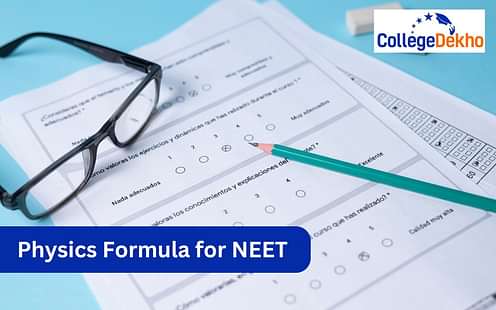
Physics Formulas for NEET 2026 exam contains formulas for various physics theories, such as the Kinematics Formula, Work, Energy and Power Formula, Electrostatics Formulas and so on. Learning formulas for NEET 2026 physics can be a very daunting task, but not anymore with the right strategy. Students must not try to mug up the formulas but rather study and understand them. They must understand the cause to figure out the effect using the formulas for the NEET physics paper. Candidates must regularly revise the physics formula for NEET to score good marks on the exam. NEEET Exam 2026 is all set to be conducted on May 4, 2026. Students must revise Physics Formulas for NEET 2026 for the exam. One of the best ways to prepare for the Physics Formulas for NEET 2026 is to solve the NEET previous year's Question Papers with Solutions . They must regularly attend the NEET 2026 Mock Test to increase their chances of securing good marks on the exam. Learning the formulas properly will help students to prepare for the NEET exam physics section. In this article, students will find the highest-scoring NEET 2026 formulas, steps to solve numericals like a pro and more.
Also Read:
| NEET 2026 Most Important Topics |
|---|
Most Scoring Physics Formula for NEET 2026
The NEET Physics 2026 Syllabus PDF contains chapters on Physics, Chemistry, and Biology from the higher secondary CBSE syllabus. Some Physics Formulas for NEET 2026 are more than the rest. Here we have provided the Most Scoring Concepts in Physics Formula Sheet NEET 2026 for the reference of interested candidates.
Title of the Concept | Name of Chapter | Frequency | Year |
|---|---|---|---|
Nature of Electromagnetic Waves | Electromagnetic Waves | 4 | 2020 to 2023 |
Logic Gates | Electronic devices | 7 | 2019, 2020 (x3), 2021, 2022, 2023 |
Series LCR Circuit | Electromagnetic Induction and Alternating Currents | 4 | 2020 to 2023 |
Resistance and Resistivity | Current Electricity | 6 | 2020 (x3), 2021, 2022, 2023 |
Kirchhoff's second law | Current Electricity | 4 | 2020 (x2), 2023 (x2) |
Young's double slit experiment | Optics | 4 | 2019, 2020, 2022, 2023 |
Equations of motion of SHM | Oscillations and Waves | 4 | 2019 (x2), 2020, 2023 |
Parallel Grouping of Resistance | Current Electricity | 4 | 2019, 2020, 2021, 2023 |
Total Internal Reflection | Optics | 4 | 2019, 2020, 2022, 2023 |
De-Broglie wavelength of an electron | Dual Nature of Matter and Radiation | 4 | 2019, 2020 (x2), 2023 |
Electric potential due to continuous charge distribution | Electrostatics | 4 | 2020, 2021 (x2), 2022 |
NEET Physics Important Formulas
Students need to prepare all the physics formulas for NEET for the accurate application of principles and physics concepts. Here are some crucial Physics formulas for NEET 2026 that one must refer to:
Boltzmann constant, k = 1.38 × 10 −23 J/K
Gravitation constant, G = 6.67×10 −11 m 3 kg −1 s −2
Planck constant, h = 6.63 × 10 −34 J.s = 4.136 × 10 -15 eV.s
a = ∆v ∆t, where A = acceleration, ∆v = change in velocity and ∆t = elapsed time.
Charge of electron, e = 1.602 × 10 −19 C
Avogadro’s number, NA = 6.023 × 10 23 mol −1
Molar gas constant, R = 8.314 J/(mol K)
∆x = vf∆t − 1/2 a(∆t) 2 where ∆x = displacement, vf = is the final velocity, ∆t = elapsed time and a = acceleration.
Wave = ∆x ∆t wave = displacement ∆t = average velocity ∆x = elapsed time.
Coulomb constant, 1/4πε 0 = 8.9875517923(14) × 10 9 N m 2 /C 2
Permittivity of vacuum 0 = 8.85 × 10 −12 F/m
Stefan-Boltzmann constant, σ = 5.67 × 10 −8 W/(m 2 K 4 )
Mass of electron, m e = 9.1 × 10 −31 kg
Faraday constant, F = 96485 C/mol
p = mv
Mass of neutron, m n = 1.6749 × 10 −27 kg
Mass of proton, m p = 1.6726 × 10 −27 kg
Standard atmosphere, atm = 1.01325 × 10 5 Pa
Rydberg constant, R ∞ = 1.097 × 10 7 m −1
Wien displacement constant, b = 2.9 × 10 −3 m K
Bohr radius, a 0 = 0.529 × 10 −10 m
Bohr magneton, µ B = 9.27 × 10 −24 J/T
F = ma where m = mass, F = force, and a = acceleration Newton’s Second Law.
F is termed as the net force on the mass m.
f = µN f = friction force, where N = normal force and µ = coefficient of friction.
Here, µ can be considered either the kinetic coefficient of friction, µk, or the static coefficient of friction.
P = W ∆t P = power, where ∆t = elapsed time and W = work.
Power is the amount of work that is done per unit of time; that is, power is the rate at which work is done.
V avg = (vi + vf*) 2 where vi = initial velocity and vf = final velocity.
KE = 1/2 mv 2 K, where KE = kinetic energy, m = mass, v = velocity.
∆x = vi∆t + 1/2 a(∆t) where ∆x = the displacement, ∆t = the elapsed time, vi = the initial velocity, and a = the acceleration.
W = mg, where m = mass, W = weight, and g = acceleration which is due to gravity.
Then, we weigh an object called mass, m. This is said to be Newton’s Second Law.
W = F.d or W = F d cos θ, where W = work, d = distance, F = force, and θ = angle between F and the direction of motion.
W = ∆(KE), where KE = kinetic energy and W = work done.
The ‘work-energy’ that we have learned is the theorem that the work done by the net force on an object equals the change in kinetic energy of the object.
We can write it as E = KE + PE, where E = total energy, KE = kinetic energy, and PE = potential energy.
Physics Chapter-wise Formulas for NEET PDF - Download Link |
|---|
How to Solve Numericals like a Pro using Physics Formulas for NEET 2026?
Important formulas for NEET physics are helpful for students while solving numerical problems. One must note that the weightage of numerical formulas is high in exams. Hence, one can follow these steps to solve the Physics Formulas for NEET 2026 like a pro.
Examine questions thoroughly and stay on the lookout for important keywords. Half of the job is done if students can understand the questions correctly.
Jot down all the given data and recognize the problem type. This will help you eliminate a few options and also clear you from the clutter of twisted question framings.
Zero in on the ideal yet effective approach to solving the numerical. Know the type of question that has been asked and solve the question with accuracy.
Once students have solved the question, they look for the answers in the options. If students cannot find the answer in the options, they choose the solution closest to the answer. Sometimes, accuracy issues occur, and hence, the answer closest to the solution can be chosen.
Be confident with the approach, and don’t second-guess the solution after attempting the question. Move on to the next numerals and keep attempting them one by one.
Best Books to Learn Physics Formulas for NEET 2026
There are several NEET Physics 2026 reference books that student can refer to. However, the reference material in the books mentioned below is considered to be the best for studying important NEET physics formulas.
Concepts of Physics by H. C. Verma
NCERT (Textbook) Physics – Class 11 and 12
Objective Physics by D. C. Pandey
Fundamentals of Physics by Halliday, Resnick, and Walker
- Problems in General Physics by I. E. Irodov
Ways to Study Physics Formulas Correctly
There are several strategies that students must apply to study physics formulas to get good scores in physics sections. Students can make a physics neet formula sheet 2026 and study it daily. Below are some of the strategies that will help students to study physics formulas more effectively.
- Understand the Concepts: Students need to understand the concept or theory behind the formulas. If they do not understand the cause, then they will not be able to understand the effect of an incident as well. Further, they should have a neet 2026 physics formula sheet that will help them to revise the formulas more effectively.
- Relate to the Formulas for Understanding: Students need to relate to the formulas by thinking about them. They can set real-life examples in a column beside the important physics formulas for neet pdf download 2026 to help them comprehend better. Setting examples will help students to revise the formulas more effectively.
- Recall the Formulas: After studying the NEET 2026 formulas, students must try to recall them from time to time. They can use the 3R technique where they read, revise and repeat to get a better understanding of their level of preparation and mark them in the neet 2026 physics formula sheet. They can write the number of times they correctly remembered the formulas and the time in which they didn’t in the neet physics formula sheet 2026. It will help them to track their progress faster and revise quickly.
Also Read: NEET 2026 Most Important Topics to Remember
Importance of NEET Physics Formulas 2026
The NEET Physics formulas are important for students as they help them to understand complex numerical problems in physics and helps them to solve effectively. There are 180 questions in the paper, and the physics section mostly consists of formula-based questions, which is essential for students to solve to get good marks on the examination. Students need to apply these formulas and solve problems to get high scores on examinations. Mastering key formulas in physics like mechanics, electromagnetism, and thermodynamics, helps students tackle complex problems efficiently. Additionally, concepts like Series LCR Circuits, Kirchhoff's laws, and Equations of Motion for SHM are frequently tested and can help students to significantly boost their physics scores. Solving these formulas will help students to build good problem-solving skills along with analytical & reasoning skills.
Also Read: NEET 2026 Chapter Wise and Subject Weightage, Important Topics
Related Articles
Revise these Chapters and Topics to Score Well in NEET 2026 Physics | |
Therefore, these were a set of physics formulas that students must know and learn to score good marks in the exams. Students must practice these formulas daily to get good marks on the examinations. They must not just blindly mug up the formulas rather they must try to understand the theory behind it. Once students understand the theory behind the formulas, they will be easily able to recall the formulas to solve any equation in the NEET exam. For any queries regarding Physics Formulas for NEET 2026, log on to our CollegeDekho QnA Zone or contact our toll-free helpline number 18005729877.
Are you feeling lost and unsure about what career path to take after completing 12th standard?
Say goodbye to confusion and hello to a bright future!

FAQs
Some of the best books to prepare for the important formulas for NEET physics include
DC Pandey's Objective Physics
I. E. Irodov's Problems in General Physics
Objective Physics by Prof. Satya Prakash Arya (MTG Publishers)
Some of the NEET physics important formulas are
Boltzmann constant: \(k=1.38\times 10^{-23}J/K\)
Planck constant: \(h=6.63\times 10^{-34}J.s=4.136\times 10^{-15}eV.s\)
Avogadro's number: \(NA=6.023\times 10^{23}mol^{-1}\)
Molar gas constant: \(R=8.314J/(molK)\)
In order to prepare all physics formulas for NEET, candidates must regularly solve the exercises that are added after each chapter. Also, it is important to solve the NEET previous year question papers to increase speed and accuracy.
Physics is about expressing real-world values instead of simply memorizing them. A formula is derived after many layers of challenges and difficulties. NEET physics important formulas allow students to understand concepts’ applications on a practical level and prepare one for future job roles. The formula also justifies the legitimacy of concepts.
The formula for angular momentum is L=I × ⍵ where L is the Angular Momentum, ⍵ is the Angular Velocity, and I is the Moment of Inertia. It is an integral part of the physics syllabus and describes the use of various appliance around us.
The formula for pressure can be defined as P=F/A. Here, P denotes pressure, F represents mass, and A is signified as area. Many numericals are asked or derived from the formula of pressure.
The formula for momentum can be defined as P = m x v. Here, P denotes momentum, m represents mass, and v is signified as velocity. Many numericals are asked from the formula of momentum in exams.
No. Although the NCERT books are extremely important. One must study the NCERT book of Physics first. Later, one needs to refer to other relevant books to successfully attempt the all physics formulas for NEET 2025.
No. But, most students lose marks in the physics section of the NEET exam. Hence, candidates must be well adept with the NEET 2025 physics formulas to improve their overall scores.
Was this article helpful?





















Similar Articles
INI CET 2026 Rank vs Percentile
What is a Good Score/Rank in INI CET 2026?
FMGE 2025 Application Form Correction: Dates, Direct Link, Process, Details to Edit
Can MBBS admission be cancelled? Reasons and Remedies
Expected Rank for 65 Percentile in INI CET January 2026
Expected Rank for 60 Percentile in INI CET January 2026